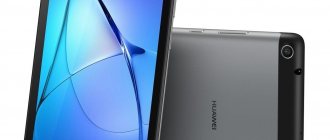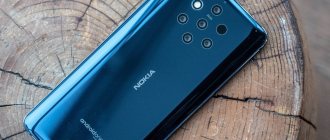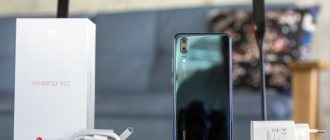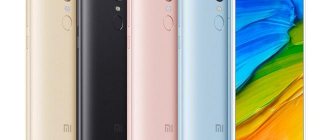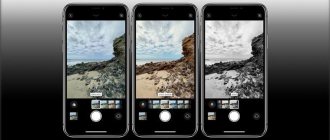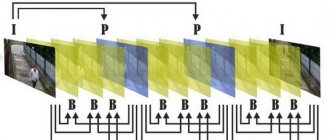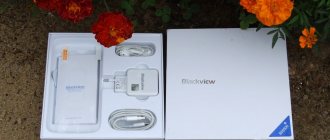We live in a time when almost every person, before buying a new smartphone, thinks about its photo and video capabilities. Now there are simply a lot of excellent camera phones on the market. And they all take approximately the same pictures. Gone are the days when the best camera was the one with more megapixels. Now other camera characteristics, such as aperture, are also important.
In 2020, Apple announced two phones: iPhone 7 and iPhone 7 Plus. The most interesting innovation is the dual camera with 2x optical zoom. Apple set a trend that was followed by most mobile manufacturers.
What is optical zoom?
Optical zoom is a function of cameras or smartphones that allows you to bring your subject closer or further away. Optical zooming is used to enlarge objects with special optical elements, so that the resolution of the photo remains unchanged.
If your camera has a 12-megapixel module, then when the object is optically zoomed in, these 12 megapixels will remain (without pixel enlargement). This article presents the best smartphones that are equipped with an optical zoom camera.
Choosing a smartphone with optical zoom: Apple, Android and alternatives
Table of contents
- Introduction
- Apple
- ASUS
- OnePlus
- Oppo
- A brief excursion into history
- What will happen next
- Alternative solutions
- Conclusion
- Specifications
Introduction
The camera (or rather, cameras) is one of the most important components of a smartphone.
For some, it’s not that important: it’s worth it, and that’s okay. At the same time, for other users, the quality of photos and videos generated by the device plays a paramount role. Previously, we have already devoted a couple of issues to choosing a smartphone, taking this aspect into account: we talked about the quality of the camera in general, and paid attention to the trend of a dual module that is fashionable today. At the same time, it was noted that in many cases the second camera is installed only as a tribute to fashion, and primarily this applies to inexpensive Chinese devices, where in most cases they imitate the bokeh effect.
But there are other scenarios for using the second module. What about optical zoom? There are often cases when it would not be superfluous at all. Today we will look at smartphones that offer this feature.
| We study the evolution of cameras in Android smartphones from 2014 to 2017. In modern times, smartphones are the most dynamically developing segment. Every year their performance grows by 30% or more, which is unattainable for a PC. But if everything is more or less clear with performance, then with cameras things are more complicated. Reviews often use subjective criteria, and only the meticulous try to understand the real state of affairs. We will make the same attempt. | Choosing an Android smartphone with the best camera We often talk about the most powerful smartphones or the longest-living ones, but not all important parameters can be expressed in numbers. For example, cameras in mobile solutions cannot be compared based on characteristics. Neither the number of megapixels, nor even the sizes of sensors or those same pixels are indicative here. So, when comparing top “camera phones,” you should seek the help of professionals. | Choosing a smartphone with a dual camera on Android and more Not all models with two main cameras are equally useful. In some cases, this highlight is really interesting, in others, the manufacturer only boasts of the very fact of having two modules, focusing on optical zoom, bokeh effect, post-focusing and other effects. In our new guide, we will look at the cases in which this function may actually be needed. |
announcements and advertising
2080 Super Gigabyte Gaming OC for 60 rubles.
Compeo.ru - the right comp store without any tricks
RTX 2060 becomes cheaper before the arrival of 3xxx
Ryzen 4000
series included in computers already in Citylink
The price of MSI RTX 2070 has collapsed after the announcement of RTX 3xxx
Core i9 10 series is half the price of the same 9 series
The price of memory has been halved in Regard - it’s more expensive everywhere
Apple
Apple iPhone 7 Plus
Of course, we will start with the iPhone 7 Plus, since it was with this smartphone that the dual-camera race began.
The manufacturer installed two 12.0 megapixel sensors. Only the optics differ: wide-angle or telephoto (equivalent to focal lengths of 28 and 56 mm). Thanks to this, you can take advantage of 2x optical zoom, which is a unique feature by the standards of mobile devices.
Does the iPhone 7 Plus' dual camera make sense? It all depends on whether you can find a use for the optical zoom. By the way, it works even while recording video, and that’s not bad. The resolution of the front module is 7.0 megapixels.
(photo source: www.trustedreviews.com)
It’s unlikely that anyone seriously studies the characteristics of an iPhone before purchasing, but we’ll still remind you of them. The smartphone uses a 5.5-inch Full HD screen, a quad-core Apple A10 Fusion chip and 3 GB of RAM. Built-in memory can be 32, 128 or 256 GB. The battery capacity is 2,900 mAh. The device body is protected from dust and moisture according to the IP67 standard.
Now the younger version of the iPhone 7 Plus with 32 GB of memory in large networks costs 54-55 thousand rubles; if you wish, you can find lower price tags.
ASUS
ASUS ZenFone 3 Zoom
ASUS has very few dual-camera smartphones in its assortment, but ASUS ZenFone 3 Zoom definitely deserves attention. From the name alone it becomes clear that it allows you to enlarge the image.
The new product was clearly developed under the impression of the iPhone 7 Plus. Two main cameras with a resolution of 12.0 megapixels (Sony IMX362 module) were also installed here. The optics differ in focal length: 25 and 59 mm. Thanks to this, a 2.3x zoom is provided (the manufacturer was probably achieving a slight advantage over a well-known opponent).
The Taiwanese also promise an increase in light sensitivity by two and a half times compared to the iPhone 7 Plus. The resolution of the front module is also slightly higher – 8.0 megapixels.
The ASUS ZenFone 3 Zoom screen is similar to the iPhone: 5.5 inches and Full HD (albeit an AMOLED matrix). But the heart of the new product is a relatively simple Qualcomm MSM8953 Snapdragon 625 processor with eight budget Cortex-A53 cores and Adreno 506 graphics. But the device boasts a 5,000 mAh battery.
(photo source: www.overclockers.ru)
At the moment, the average (aka maximum) price tag of ASUS ZenFone 3 Zoom in Russian retail is 30,000 rubles. If you order from China, you can meet 25 thousand.
iPhone 8 Plus
This smartphone was introduced a couple of weeks ago. Just a few days later, the DxOMark resource rated the device’s camera as the best on the market. Let us remind you that the iPhone 8 Plus has a dual camera of 12 megapixels, the main one with f/1.8 aperture, and the second one with f/2.8 aperture. The camera specifications have not changed compared to the iPhone 7 Plus.
The second camera has an optical zoom with 2x zoom for creating beautiful portrait shots. And this is definitely one of the best and most compact optical zoom smartphones you can buy today.
Smartphone Specifications:
- Display: 5.5 inches Retina, 1920×1080p, 401 ppi
- Processor: Apple A11 Bionic
- RAM: 3 GB, LPDDR4
- Flash memory: 64/256 GB
- Main camera: 12 MP + 12 MP, f/1.8 and f/2.8
- Front camera: 7 MP, f/2.2
- Battery: 2691 mAh
- Navigation: GPS, GLONASS
- Wireless interfaces: Wi-Fi, Bluetooth, NFC
- Operating system: iOS 11
- Dimensions: 158.4×78.1×7.5 mm
- Weight: 202 grams
Leader – Huawei P30 Pro
The coolest camera phone on the market with a unique telephoto camera is the P30 Pro from Huawei. There is a cool OLED matrix, a 7nm HiSilicon Kirin 980 processor, as well as a 3-module camera with a 40 MP main sensor resolution. An additional camera has wide-angle optics, the third has a periscope telephoto lens with a resolution of 8 megapixels and an f/3.4 aperture; it also has optical stabilization, phase detection autofocus, and most importantly, 5x zoom.
Examples of photos:
Main camera
Telephoto (5x zoom)
Main camera
Telephoto (5x zoom)
Main camera
Telephoto (5x zoom) [collapse]
Plus, the Huawei P30 Pro comes with other flagship things: an acoustic resonator instead of a speaker, wireless and reverse charging, the best fast charging on the market with a 40 W adapter, which gives 70% in 30 minutes, etc. IMHO, there is nothing better on the market, and even the new Samsung Galaxy Note 10 is not a competitor to the Huawei P30 Pro in terms of zoom shooting quality.
Offers:
Xiaomi Mi6
Xiaomi's flagship has become very popular this year, thanks to its price and decent characteristics. It was introduced almost six months ago. It has an excellent top-end Snapdragon 835 processor, a beautiful glass body with a metal frame, and of course, an impressive dual camera.
Xiaomi Mi6 was equipped with two 12-megapixel modules. The first one has an aperture of f/1.8, and the second one has an aperture of f/2.6. The device has 2x optical stabilization; with the help of the bark you can take excellent portrait photographs with a bokeh effect. This is the most budget camera phone with true 2x zoom on the market.
Smartphone Specifications:
- Display: 5.15 inches, IPS LCD, 1920×1080p, 428 ppi
- Processor: Qualcomm Snapdragon 835
- RAM: 6 GB, LPDDR4
- Flash memory: 64/128 GB
- Main camera: 12 MP + 12 MP, f/1.8 and f/2.6
- Front camera: 8 MP
- Battery: 3350 mAh
- Navigation: GPS, GLONASS
- Wireless interfaces: Wi-Fi, Bluetooth, NFC
- Operating system: MIUI V9 (Android 7.1.1 Nougat)
- Dimensions: 145.2×70.5×7.5 mm
- Weight: 168 grams
Inexpensive smartphones with good cameras
Good doesn't mean expensive. And this was once again proven by Samsung, Xiaomi and Realme. They brought to the market high-quality phones with a good camera and at a low price.
Huawei P40 Lite E 4/64GB
pros
- Low price
- 6.4-inch IPS color screen
- 3 main cameras
- Front camera – 8 MP
- Autonomy
Minuses
- Photo quality drops in poor lighting
From 9,890 ₽
For a more than affordable price, the developers offered a cool device with a unique design, an excellent bright display and high performance. The quality of the front camera is very good. Selfie photos come out with high detail and without distortion. If desired, you can add a beautiful bokeh effect (blur the background in the photo). The main camera, for a budget smartphone, is quite good - as much as 48 megapixels. You can apply color filters and manually change the focus method and exposure time. For the money, this is one of the best cameras for photography.
Xiaomi Redmi Note 7 32 GB
pros
- 2 main cameras
- Front camera – 13 MP
- 6.3-inch IPS color screen
- Capacious 4000 mAh battery
- Fingerprint sensor
- Voice control
Minuses
- No NFC
- Not the most convenient location of the fingerprint scanner
From 9,630 ₽
Xiaomi can rightfully be proud of its brainchild. Bright, fast and autonomous, Redmi Note 7 has become one of the most successful and popular models among budget phones. In daylight and artificial lighting, the pictures are of fairly high quality. The front camera with built-in beauty factor and autofocus allows you to take cool selfies. There is little native memory, but you can insert a memory card up to 256 GB. The quality of the photo is lost when zooming too far and in poor lighting, but for such a price this is quite acceptable.
Samsung Galaxy A10
pros
- Color IPS 6.2-inch edge-to-edge screen
- Main camera – 13 MP with F/1.90 aperture
- Good autonomy
- 8-core processor
- Macro mode
- User-friendly interface and stylish design
Minuses
- No fingerprint scanner
- No NFC
- Low internal memory
From 7,780 ₽
A good model for those who value quality and reliability without unnecessary bells and whistles. A good build, without any gaps or cracks, and a bright design, with the ability to choose the color of the back panel, makes the Galaxy A10 attractive to buyers of all ages. There is a slot for a memory card. Easy to use and holds a charge well (up to 2 days). The quality of shooting (both on the main camera and on the front) is more than decent for this price segment. In good lighting, the photos turn out bright and juicy. Compared to more expensive models, there is a slight lack of detail, but against the background of other advantages, you can close your eyes to this.
Moto Z2 Force + Hasselblad True Zoom
The smartphone was introduced relatively recently and it is not yet sold in our countries. Motorola's modular Z line is a little over two years old. The company has updated its flagship. This flagship turned out to be quite interesting from a camera point of view. It has top-end specifications, an ultra-thin aluminum body and a dual camera. But it doesn't have optical zoom.
You may ask, why is it on this list? It's all about Moto Mods. A year ago, together with the first generation of Moto Z, the company announced a number of modules, one of which was Hasselblad True Zoom. This is a camera module that has a tenx optical zoom (the ability to operate a smartphone with a 5x zoom) and the ability to take photographs in RAW. It is worth remembering that this mod is compatible with the entire Z line.
Smartphone Specifications:
- Display: 5.5 inches, P-OLED, 2560×1440p, 534 ppi
- Processor: Qualcomm Snapdragon 835
- RAM: 4/6 GB, LPDDR4
- Flash memory: 64/128 GB
- Main camera: 12 MP + 12 MP, f/2.0 and f/2.0
- Front camera: 5 MP
- Battery: 2730 mAh
- Navigation: GPS, GLONASS
- Wireless interfaces: Wi-Fi, Bluetooth, NFC
- Operating system: stock Android 7.1.1 Nougat
- Dimensions: 155.8×76×6.1 mm
- Weight: 143 grams
Xiaomi Mi 6 (27 thousand rubles on AliExpress, 2x zoom)
The new Xiaomi flagship is not officially delivered to us (yet), so it will have to be ordered from China. If the package is not turned over by customs, as is often the case with Xiaomi devices lately, you will receive a nice glass smartphone with a pair of rear cameras and 2x zoom. It is also worth noting the protection against splashing water and the most powerful hardware platform – Snapdragon 835.
ASUS ZenFone 3 Zoom
Asus already had one attempt to make a good camera phone, but unfortunately, it failed. This time the company gathered with renewed vigor and showed the new ZenFone 3 Zoom in January of this year. The smartphone was able to surprise everyone with its simply huge 5000 mAh battery.
But the main feature of this mobile phone was its dual camera. It was equipped with a 12 megapixel dual module. The first camera received excellent aperture with an aperture of f/1.7, and the second - f/2.8. The second camera module received a 2.3x optical zoom.
Smartphone Specifications:
- Display: 5.5 inches AMOLED, 1920×1080p, 401 ppi
- Processor: Qualcomm Snapdragon 625
- RAM: 3/4 GB, LPDDR4
- Flash memory: 32/64/128 GB
- Main camera: 12 MP + 12 MP, f/1.7 and f/2.8
- Front camera: 13 MP
- Battery: 5000 mAh
- Navigation: GPS, GLONASS
- Wireless interfaces: Wi-Fi, Bluetooth, NFC
- Operating system: stock Android 7.1.1 Nougat
- Dimensions: 154.3×77×8 mm
- Weight: 170 grams
Honor 20 Pro
The two smartphones above have a 5x optical zoom function. There are no other phones on the market with similar functionality. Next in the TOP is Honor 20 Pro from Huawei, a new camera phone with a Sony IMX 586 main camera with optics with a record-breaking f/1.4 aperture and optical stabilization.
Additional cameras – with wide-angle and telephoto optics. The latter has a resolution of 8 megapixels, f/2.4 aperture, optical stabilization and a 3x zoom function. And another feature is a dedicated macro camera with a resolution of 2 MP and a fixed focus at a distance of 4 cm.
Examples of photos – in the review of Honor 20 Pro
Good battery, best hardware Kirin 980, fast charging included. Disadvantages: a low-contrast screen, lack of stereo speakers, autofocus on the front camera, and a slot for a flash drive. Still, Honor 20 Pro is cheaper than previous phones in the rating, which means you can turn a blind eye to some shortcomings.
Offers:
Xiaomi Mi A1
This bright smartphone, naturally, is not the best of all the above devices in terms of technical characteristics. But it was not by chance that he was included in this list. In fact, this is the only phone in its price class with a dual wide-angle camera and optical zoom. This is also a device from the Android One program.
Xiaomi Mi A1 has an all-metal body, a fingerprint scanner, a good 5.5-inch Full HD screen with a resolution of 1920×1080p, an eight-core Snapdragon 625 processor and a dual 12-megapixel camera with f/2.2 and f/2.6 apertures.
Smartphone Specifications:
- Display: 5.5 inches, 1920×1080p, 401 ppi
- Processor: Qualcomm Snapdragon 625, 8 cores
- RAM: 4 GB, LPDDR3
- Flash memory: 64 GB
- Main camera: dual 12 MP + 12 MP, f/2.2 and f/2.6
- Front camera: 5 MP
- Battery: 3080 mAh
- Navigation: GPS, GLONASS
- Wireless interfaces: Wi-Fi, Bluetooth
- Operating system: pure Android 7.1.2
- Dimensions: 155.4×75.8×7.3 mm
- Weight: 165 grams
OnePlus 7T Pro
- Display: 6.67 inches, AMOLED, QHD+
- Processor: Snapdragon 855+
- Memory (RAM/ROM): from 8 GB / 256 GB
- Camera (main/front): 48+8+16 MP / 16 MP
- Battery: 4,000 mAh
Price: from 45,000 rubles
The 7T Pro is considered by many to be the best smartphone of 2020. To a greater extent, it attracted users due to its combination of characteristics - powerful, beautiful, excellent display, good camera, stereo sound. But still, the quality of photos is often inferior to competitors’ flagships. However, this is a great device with optical stabilization and 3x zoom.
Also worth mentioning is the new OnePlus 8 Pro. This is a phone that has everything that was missing in previous models. However, it is expensive, and users' opinions about its camera vary greatly - some say that it is cool, while others strongly criticize it.
OnePlus 5
This phone was announced this summer as a “flagship killer.” It received flagship characteristics: Qualcomm Snapdragon 835, 6 GB or 8 GB of RAM, as well as 64 GB or 128 GB of built-in, 5.5-inch Optic AMOLED screen with Full HD resolution.
The main feature of OnePlus 5 is its dual 16-megapixel camera with f/1.7 and f/2.6 apertures, as well as the presence of 2x optical zoom. But not everything is so good. After the announcement, the craftsmen were able to understand the technology and found out that the smartphone received a 1.6x optical and 0.4-digit zoom. This caused outrage among many users. But, despite this, the smartphone deserves to be in this rating of camera phones.
Huawei Mate 20 Pro
Last year's flagship from Huawei, which is more expensive than Honor 20 Pro, but cheaper than P30 Pro. It has a cool 7-nm Kirin 980 processor, an OLED screen and a 3-module camera with a 40 MP main sensor and f/1.8 aperture. There is also a wide-angle and telephoto camera with a resolution of 8 megapixels, an f/2.4 aperture, optical stabilization, and most importantly, a 3x optical zoom function.
Of course, there is water protection, stereo speakers, fast, wireless and reverse charging, NFC and even a display with HDR10 support and Gorilla Glass 5. In terms of photography, the Huawei Mate 20 Pro is worse than the Honor 20 Pro, which is why it gets 4 place. In all other respects, the Mate 20 Pro is better, and if you don't have 10 thousand rubles for the Huawei P30 Pro, then it makes sense to consider the Mate 20 Pro.
Offers:
Please rate the article:
Huawei Honor 6x
Huaewei Honor 6x is an excellent choice for those who are used to using a smartphone instead of a camera. The performance of the device is provided by the HiSiliconKirin 655 processor, consisting of 8 cores. Screen diagonal – 5.5″, resolution – 1920x1080 MP (Full HD). The battery capacity is not too impressive: 3340 mAh. The built-in NFC module allows you to pay contactlessly for purchases. The price of the gadget is about $220.
The main camera has a Sony IMX 386 module with a resolution of 12 megapixels (3970x2975) and f/2.2 aperture. Such matrices are installed on flagship models, and you can be confident in their quality. Additionally, the device has a 2 MP wide-angle module. It is needed to blur the background and achieve excellent detail of the objects being photographed. It can also be used to change focus.
Huaewei Honor 6x shoots well both in the sun and in dim lighting. The quality of the sensor is indicated by the uniformity of illumination and sharpness across the entire width of the picture. Clarity is maintained even when shooting at night, as long as the light is distributed evenly. At this time of day, noise may appear in the absence of additional lighting sources. For advanced users, there is a wide range of camera settings available.
Samsung Galaxy Note 9 - a powerful phablet
Galaxy Note is a trend-setting line with a whole range of unique features. The advantage is the presence of a G-pen stylus, using which you can control the operation of the device remotely, including taking pictures.
The model is positioned as a smartphone for creative people who are not used to technology limiting their potential.
Samsung Galaxy Note 9 combines a large diagonal screen, a top-end camera, and advanced software.
Advantages:
- screen color rendering;
- stylus;
- fast charging;
- good indicator of autonomy;
- Always On Display;
- waterproof housing;
- accurate biometric sensors.
Flaws:
- massive body;
- noise reduction is not always correct;
- curved edges create glare;
More about Samsung Galaxy Note 9 ►
What is the disadvantage of digital zoom?
Even with slight magnification, you will definitely notice a loss in image quality when using digital zoom. Guaranteed.
Just think about it. If you take a photo at a typical resolution of 4000 x 3000 (12 MP) and crop it down to 3000 x 2000 (6 MP), you will definitely lose some detail and sharpness in the image by trying to stretch it to the size of a 12 MP photo. This happens because you will reduce the resolution of the photo by half and enlarge it to its original size. example
What's the Disadvantage of Digital Zoom
Smartphone manufacturers have come up with different methods to fill these pixel data gaps. One way to do this is interpolation. The camera algorithm looks at nearby pixels and makes calculations to determine which color pixel is needed to fill the gap.
It is this combination of real pixel data and software pixel interpolation that produces the final digital enlargement of the image. The results of this vary from manufacturer to manufacturer depending on the complexity of their algorithms, but it is usually not all that effective. Therefore, photographs may lose real quality!

